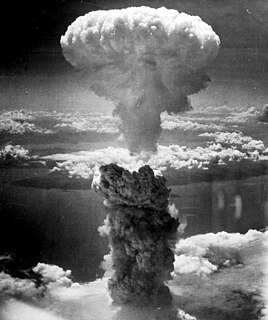A neutron bomb, officially defined as a type of enhanced radiation weapon (ERW), is a low yield thermonuclear weapon designed to maximize lethal neutron radiation in the immediate vicinity of the blast while minimizing the physical power of the blast itself. The neutron release generated by a nuclear fusion reaction is intentionally allowed to escape the weapon, rather than being absorbed by its other components. The neutron burst, which is used as the primary destructive action of the warhead, is able to penetrate enemy armor more effectively than a conventional warhead, thus making it more lethal as a tactical weapon.

Stockpile stewardship refers to the United States program of reliability testing and maintenance of its nuclear weapons without the use of nuclear testing.
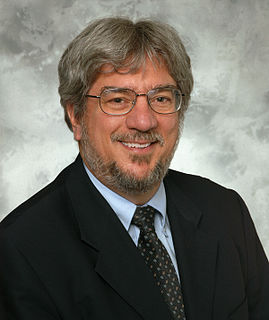
Michael Anastasio led two national science laboratories during a time of transition. He was the director of the Los Alamos National Laboratory and president of the Los Alamos National Security LLC, the company that operates the laboratory. He is the former director of Lawrence Livermore National Laboratory (LLNL). The University of California Board of Regents appointed Michael R. Anastasio the director of LLNL on June 4, 2002. He started on July 1, 2002. In 2005 he became the president of the Los Alamos National Security LLC, and became the director of the Los Alamos National Laboratory on June 1, 2006. During his directorship at Lawrence Livermore, the laboratory won 25 R&D 100 Awards and maintained its world-class leadership position in high-performance computing and its application to global climate modeling.

The W81 was a planned US warhead to be mounted on the SM-2 surface-to-air missile used by the US Navy. The W81 was believed to be derived from the B61 nuclear bomb which forms the backbone of the current US nuclear gravity bomb arsenal and from which the W80 cruise missile warhead is derived. The weapon was being designed at Los Alamos National Laboratory.
The W50 was an American thermonuclear warhead used on the MGM-31 Pershing intermediate range nuclear missile. It was also used on the LIM-49 Nike Zeus anti-ballistic missile, but this program was cancelled before deployment. The W50 was developed by the Los Alamos National Laboratory.

The W87 is an American thermonuclear missile warhead. It was created for use on the LGM-118A Peacekeeper ICBM, 50 of which, with up to 10 warheads per missile, were deployed 1986–2005. Starting in 2007, 250 of the W87 warheads from now-retired Peacekeeper missiles were retrofitted onto much older Minuteman III missiles, with one warhead per missile.

The W84 is an American thermonuclear warhead designed for use on the BGM-109G Gryphon Ground Launched Cruise Missile (GLCM). It is a derivative of the B61 nuclear bomb design and a close relative of the W80 warhead used on the AGM-86 ALCM, AGM-129 ACM, and BGM-109 Tomahawk SLCM cruise missiles.
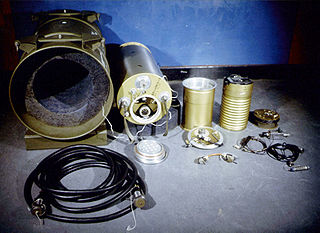
The W45 was a multipurpose American nuclear warhead developed in the early 1960s, first built in 1962 and fielded in some applications until 1988. It had a diameter of 11.5 inches, a length of 27 inches and weighed 150 pounds. The yields of different W45 versions were 0.5, 1, 5, 8, 10, and 15 kilotons. The W45 was designed at the Livermore branch of the University of California Radiation Laboratory (UCRL), now Lawrence Livermore National Laboratory.

The MGM-52 Lance is a mobile field artillery tactical surface-to-surface missile system used to provide both nuclear and conventional fire support to the United States Army. The missile's warhead was developed at Lawrence Livermore National Laboratory. It was replaced by MGM-140 ATACMS, which was initially intended to likewise have a nuclear capability during the Cold War.

The W89 was an American thermonuclear warhead design intended for use on the AGM-131 SRAM II air to ground nuclear missile.
The W67 was an American thermonuclear warhead which was developed in the mid-1960s but then cancelled prior to any production or service use in 1967.
The Mark 27 nuclear bomb and closely related W27 warhead were two American thermonuclear bomb designs from the late 1950s.
The W82 was a low-yield tactical nuclear warhead developed by the United States and designed to be used in a 155 mm artillery shell. It was conceived as a more flexible replacement for the W48, the previous generation of 155 mm nuclear artillery shell. A previous attempt to replace the W48 with the W74 munition was canceled due to cost.
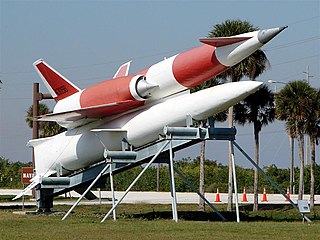
W41 was the designation of an American nuclear warhead, which was investigated during the late 1950s. Intended for use in the SM-64 Navaho cruise missile, the program was cancelled in 1957. The program was brief, considered at the same time as the TX-29, WX-15-X1 and XW-21 warheads. All were eventually replaced as the proposed Navaho warhead by the W39. The W41 was an adaptation of the B41 thermonuclear bomb which was produced in large numbers and served in stockpile for 15 years.
The W63 was the Lawrence Livermore Laboratory's entry into a brief competition between Livermore and Los Alamos to design a warhead for the Army's Lance tactical surface to surface missile.
The W65 was the Lawrence Livermore Lab's competitor for the warhead of the Sprint anti-ballistic missile. Development of the W65 started in October 1965 and was terminated in January 1968 in favor of the Los Alamos W66 design. The W65 was an "enhanced radiation" weapon whose kill mechanism was the neutron flux.
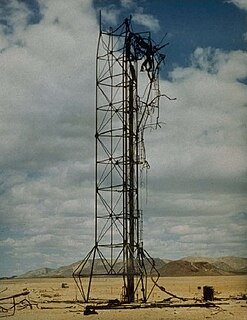
The uranium hydride bomb was a variant design of the atomic bomb first suggested by Robert Oppenheimer in 1939 and advocated and tested by Edward Teller. It used deuterium, an isotope of hydrogen, as a neutron moderator in a uranium-deuterium ceramic compact. Unlike all other fission-based weapon types, the concept relies on a chain reaction of slow nuclear fission. Bomb efficiency was adversely affected by the cooling of neutrons since the latter delays the reaction, as delineated by Rob Serber in his 1992 extension of the original Los Alamos Primer.
